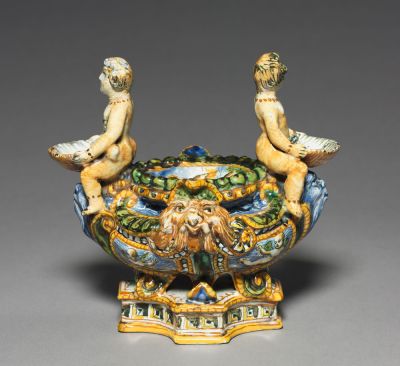Condimento esaltatore del gusto ed agente conservante dei cibi, il sale è sempre stata una sostanza pregiata e ricercata. Nel Rinascimento il controllo del mercato del sale scatenò guerre più o meno durature in ogni angolo del mondo e ogni Stato applicò imposte per rimpinguare le proprie casse. In questo contesto, dal medioevo e fino al Seicento inoltrato, il centrotavola in ogni banchetto di alto rango era una magnifica saliera, stupefacente per forma e raffinatezza, nella cui realizzazione si impegnarono i più abili e fantasiosi artigiani medievali e rinascimentali. La saliera, oltre a un uso pratico, ebbe sempre un alto valore cerimoniale: la sua funzione era quella di separare il signore e i suoi più importanti ospiti dal resto dei convitati, definendo un al di qua e un al di là nell’assegnazione dei posti a tavola. La collezione del Museo d’Arte di Cleveland annovera la presenza di una coppia di saliere in ceramica realizzata a Urbino durante la seconda metà del XVI secolo, ciascuna decorata con due putti che sorreggono un guscio di capasanta, nel cui incavo si collocava il sale. Sono realizzate in terracottta smaltata a stagno e decorate con colori vivaci con una tecnica chiamata “maiolica”.
During the Renaissance, salt was an expensive commodity. It was used not only for seasoning food, but also for preserving it. Rulers levied high tariffs on salt and allowed monopolies on who could import and sell it. In this historical context, it is not surprising that salt was an important centerpiece of the medieval and Renaissance tabletop. In the wealthiest homes and palaces, salt was served in ornate containers called salt cellars or, simply, “salts” that sat in front of the host or the honored guest. Salt at the time was too coarse to be used in modern-style salt shakers familiar to us today. Instead, guests would take salt from the cellar using small spoons or the back of a flat knife. Small, covered salt cellars were a key feature of more modest tables, as well. Salts were produced in a variety of materials including precious metals, glass and even ceramics. Medieval inventories record fantastic salt cellars incorporating figures of human beings and animals. Others were fashioned as sailing ships.
The visitor to the Renaissance galleries of the Cleveland Museum of Art will note the presence of a matching pair of ceramic table salts made in Urbino during the second half of the 16th century. Each is about 8 inches in height and each feature two putti (nude, cherub-like children common in Renaissance art). Each putto holds a scallop shell. The salt could be placed in the depressions formed by the shells and in the large depression at the center of the salt. These handsome objects would have graced an affluent table. They are colorfully painted and made from tin-glazed earthenware, a technique we call “maiolica.”
Maiolica products are well-known today in gift shops in cities like Siena, Gubbio, Faenza, Deruta, and Urbino, towns where they were historically made. In the 1400s, maiolica achieved a prominent presence in Italian homes and palaces, as evidenced by its depiction in countless paintings and frescoes, a sign of its high status. In this period, maiolica was used to equip many townhomes and country villas of the elite, at a time when such spaces were acquiring richer furnishings. Italian maiolica gained popularity outside of Italy, as well, and much was produced for the export market. The potters themselves boasted of their success. In their 1498 tax return, the leading Masci family of potters in Deruta was able to claim that their maiolica sold to Perugia was “beautiful and unheard of and sold throughout the whole world and, because of this, the city of Perugia takes pride and increases its fame, and everyone wonders to see these maiolica works.”
It was not uncommon for the Italian elite of the 1400s and 1500s to order large services of maiolica including plates, bowls, ewers (pitchers), salts, and other items. These could number in the hundreds. The Cleveland salts undoubtedly come from such a set. The most famous example is a set of Urbino maiolica ordered by Eleonora Gonzaga as a gift for her mother Isabella d’Este in 1534. The wares of Urbino began to dominate the market from the 1520s onwards. Urbino is a walled city in the Marche region of Italy, south-west of Pesaro, a World Heritage Site notable for a remarkable historical legacy of independent Renaissance culture, especially under the patronage of Federico da Montefeltro, duke of Urbino from 1444 to 1482. Urbino’s maiolica from the late 15th and early 16th centuries adopted a pictorial style called istoriato featuring biblical or narrative scenes. By the second half of the 16th century, a style called “grotesque,” inspired by the painter Raphael, was more common and revealed an interest in ancient history and mythology. The two salts now in Cleveland belong to this period.
Salt shakers, as we know them today, began to appear in the Victorian era and patents show attempts to deal with the problem of salt clumping, but they remained the exception rather than the norm. It was not until after 1911, when anti-caking agents began to be added to table salt, that salt shakers gained favor and open salts began to fall into disuse. It is not known who commissioned the Cleveland salts, nor the artist who made them. However, these handsome objects reveal much about Italian table practices in the 1500s. They also provide splendid examples of the art of maiolica, an art form mastered by Italian ceramists in the Renaissance, widely imitated, but never superseded.



